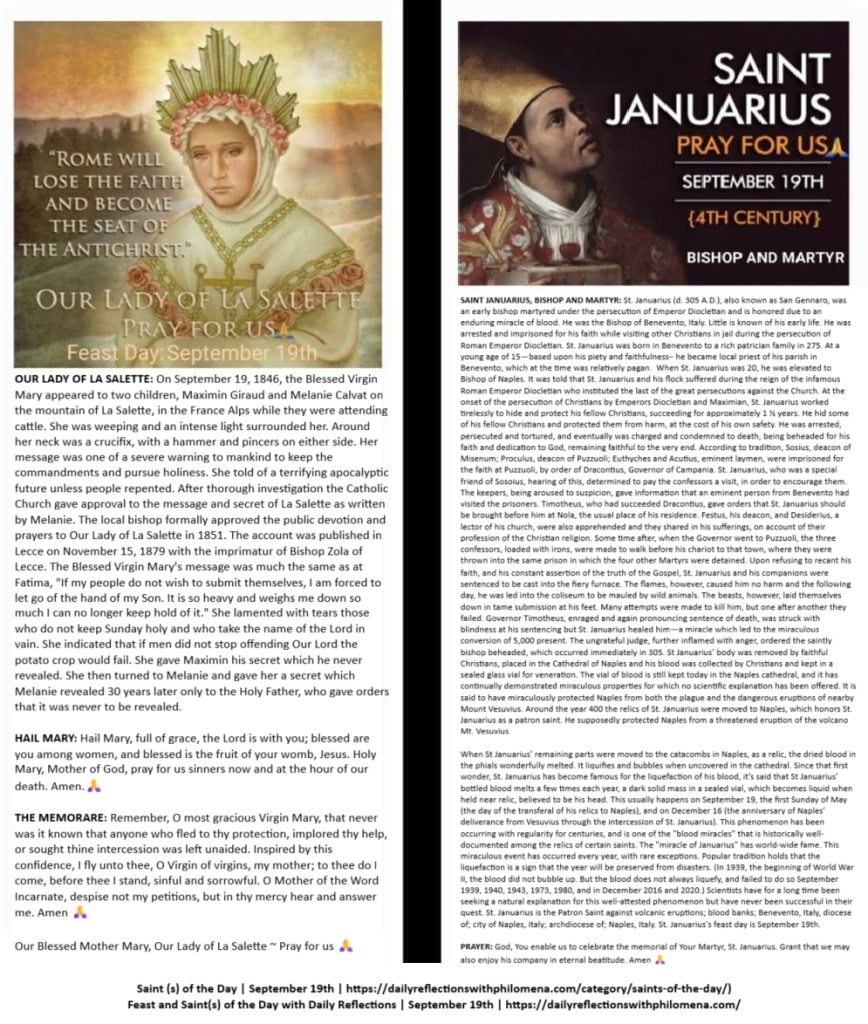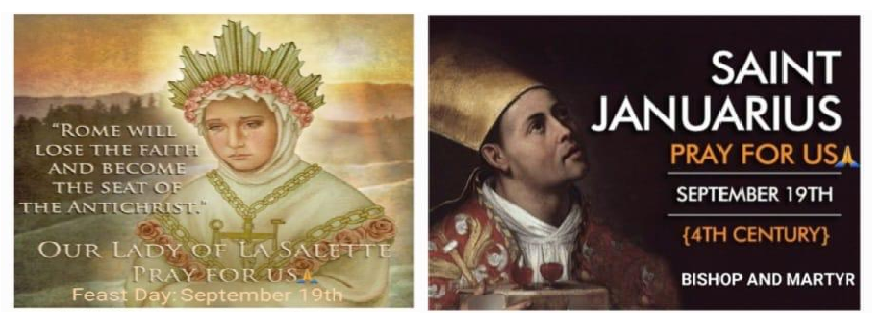
FEAST OF OUR LADY OF LA SALETTE; MEMORIAL OF SAINT JANUARIUS, BISHOP AND MARTYR ~ FEAST DAY ~ SEPTEMBER 19TH: Today, we celebrate the Feast of Our Lady of La Salette and the Memorial of Saint Januarius, Bishop and Martyr. Through the intercession of our Blessed Mother Mary and the Saint Januarius on this feast day, we humbly pray against natural disasters. We pray for the sick and dying, especially those who are mentally and physically ill, and those suffering from cancers and other terminal diseases. We pray for the souls in Purgatory and the repose of the souls of the faithful departed. We pray for the poor and needy, for all widows and widowers, for peace, love, and unity in our marriages, our families and our world. And we continue to pray for our Holy Father, Pope Francis, the Bishops, the Clergy, for vocations to the priesthood and religious life, for the Church, for persecuted christians, for the conversion of sinners, and Christians all over the world…. Amen🙏
OUR LADY OF LA SALETTE: On September 19, 1846, the Blessed Virgin Mary appeared to two children, Maximin Giraud and Melanie Calvat on the mountain of La Salette, in the France Alps while they were attending cattle. She was weeping and an intense light surrounded her. Around her neck was a crucifix, with a hammer and pincers on either side. Her message was one of a severe warning to mankind to keep the commandments and pursue holiness. She told of a terrifying apocalyptic future unless people repented. After thorough investigation the Catholic Church gave approval to the message and secret of La Salette as written by Melanie. The local bishop formally approved the public devotion and prayers to Our Lady of La Salette in 1851. The account was published in Lecce on November 15, 1879 with the imprimatur of Bishop Zola of Lecce. The Blessed Virgin Mary’s message was much the same as at Fatima, “If my people do not wish to submit themselves, I am forced to let go of the hand of my Son. It is so heavy and weighs me down so much I can no longer keep hold of it.” She lamented with tears those who do not keep Sunday holy and who take the name of the Lord in vain. She indicated that if men did not stop offending Our Lord the potato crop would fail. She gave Maximin his secret which he never revealed. She then turned to Melanie and gave her a secret which Melanie revealed 30 years later only to the Holy Father, who gave orders that it was never to be revealed.
HAIL MARY: Hail Mary, full of grace, the Lord is with you; blessed are you among women, and blessed is the fruit of your womb, Jesus. Holy Mary, Mother of God, pray for us sinners now and at the hour of our death. Amen.🙏
THE MEMORARE: Remember, O most gracious Virgin Mary, that never was it known that anyone who fled to thy protection, implored thy help, or sought thine intercession was left unaided. Inspired by this confidence, I fly unto thee, O Virgin of virgins, my mother; to thee do I come, before thee I stand, sinful and sorrowful. O Mother of the Word Incarnate, despise not my petitions, but in thy mercy hear and answer me. Amen 🙏
Our Blessed Mother Mary, Our Lady of La Salette ~ Pray for us 🙏
SAINT JANUARIUS, BISHOP AND MARTYR: St. Januarius (d. 305 A.D.), also known as San Gennaro, was an early bishop martyred under the persecution of Emperor Diocletian and is honored due to an enduring miracle of blood. He was the Bishop of Benevento, Italy. Little is known of his early life. He was arrested and imprisoned for his faith while visiting other Christians in jail during the persecution of Roman Emperor Diocletian. St. Januarius was born in Benevento to a rich patrician family in 275. At a young age of 15—based upon his piety and faithfulness– he became local priest of his parish in Benevento, which at the time was relatively pagan. When St. Januarius was 20, he was elevated to Bishop of Naples. It was told that St. Januarius and his flock suffered during the reign of the infamous Roman Emperor Diocletian who instituted the last of the great persecutions against the Church. At the onset of the persecution of Christians by Emperors Diocletian and Maximian, St. Januarius worked tirelessly to hide and protect his fellow Christians, succeeding for approximately 1 ½ years. He hid some of his fellow Christians and protected them from harm, at the cost of his own safety. He was arrested, persecuted and tortured, and eventually was charged and condemned to death, being beheaded for his faith and dedication to God, remaining faithful to the very end. According to tradition, Sosius, deacon of Misenum; Proculus, deacon of Puzzuoli; Euthyches and Acutius, eminent laymen, were imprisoned for the faith at Puzzuoli, by order of Dracontius, Governor of Campania. St. Januarius, who was a special friend of Sosoius, hearing of this, determined to pay the confessors a visit, in order to encourage them. The keepers, being aroused to suspicion, gave information that an eminent person from Benevento had visited the prisoners. Timotheus, who had succeeded Dracontius, gave orders that St. Januarius should be brought before him at Nola, the usual place of his residence. Festus, his deacon, and Desiderius, a lector of his church, were also apprehended and they shared in his sufferings, on account of their profession of the Christian religion. Some time after, when the Governor went to Puzzuoli, the three confessors, loaded with irons, were made to walk before his chariot to that town, where they were thrown into the same prison in which the four other Martyrs were detained. Upon refusing to recant his faith, and his constant assertion of the truth of the Gospel, St. Januarius and his companions were sentenced to be cast into the fiery furnace. The flames, however, caused him no harm and the following day, he was led into the coliseum to be mauled by wild animals. The beasts, however, laid themselves down in tame submission at his feet. Many attempts were made to kill him, but one after another they failed. Governor Timotheus, enraged and again pronouncing sentence of death, was struck with blindness at his sentencing but St. Januarius healed him—a miracle which led to the miraculous conversion of 5,000 present. The ungrateful judge, further inflamed with anger, ordered the saintly bishop beheaded, which occurred immediately in 305. St Januarius’ body was removed by faithful Christians, placed in the Cathedral of Naples and his blood was collected by Christians and kept in a sealed glass vial for veneration. The vial of blood is still kept today in the Naples cathedral, and it has continually demonstrated miraculous properties for which no scientific explanation has been offered. It is said to have miraculously protected Naples from both the plague and the dangerous eruptions of nearby Mount Vesuvius. Around the year 400 the relics of St. Januarius were moved to Naples, which honors St. Januarius as a patron saint. He supposedly protected Naples from a threatened eruption of the volcano Mt. Vesuvius.
When St Januarius’ remaining parts were moved to the catacombs in Naples, as a relic, the dried blood in the phials wonderfully melted. It liquifies and bubbles when uncovered in the cathedral. Since that first wonder, St. Januarius has become famous for the liquefaction of his blood, it’s said that St Januarius’ bottled blood melts a few times each year, a dark solid mass in a sealed vial, which becomes liquid when held near relic, believed to be his head. This usually happens on September 19, the first Sunday of May (the day of the transferal of his relics to Naples), and on December 16 (the anniversary of Naples’ deliverance from Vesuvius through the intercession of St. Januarius). This phenomenon has been occurring with regularity for centuries, and is one of the “blood miracles” that is historically well-documented among the relics of certain saints. The “miracle of Januarius” has world-wide fame. This miraculous event has occurred every year, with rare exceptions. Popular tradition holds that the liquefaction is a sign that the year will be preserved from disasters. (In 1939, the beginning of World War II, the blood did not bubble up. But the blood does not always liquefy, and failed to do so September 1939, 1940, 1943, 1973, 1980, and in December 2016 and 2020.) Scientists have for a long time been seeking a natural explanation for this well-attested phenomenon but have never been successful in their quest. St. Januarius is the Patron Saint against volcanic eruptions; blood banks; Benevento, Italy, diocese of; city of Naples, Italy; archdiocese of; Naples, Italy. St. Januarius’s feast day is September 19th.
PRAYER: God, You enable us to celebrate the memorial of Your Martyr, St. Januarius. Grant that we may also enjoy his company in eternal beatitude. Amen 🙏
